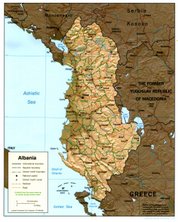A friend, who lives in NY, made a short trip last week to the northern Albanian city of Shkodra, where she has relatives, and, on her way back home, we agreed to meet in Tirana. I invited her to stay with me and she readily accepted when I suggested to arrive here at least on Monday night, since she had to fly out of Albania on Wednesday morning.
She visited Shkodra repeatedly since 2006, but had not yet had the chance to really get acquainted with the capital.
After her arrival on Monday night we had a late dinner at an Italian restaurant, located just one block away from my apartment. The plans we made on how to spend her only full day in this capital went out of the window the next morning, when we had a leisure breakfast. Somehow, however, we ended up doing a lot during the rest of the day, and by the end of it we were both exhausted.
As we went along, we laughingly kept on telling each other that this was really a typical Albanian way of living. Without rushing, we were able to move around and see several things and places, and also tour the National Albanian Historic Museum in the center of the famously large Skanderbeg square. This city center area is now really messy and difficult to navigate for both cars and pedestrians because, according to an ambitious urban plan, it's being reconstructed and completely repaved.
We managed to have an aperitiv at one of the hundreds outdoor bars of Tirana with another American woman, widow of an Albanian. She resides in California, but at the tender age of 80, spends about 6 months a year in this city, where she rents an apartment, goes to a gym twice a week, and even teaches journalism at a local private school.
Afterwards, we had a satisfying lunch at one of my favorite places in town. Their, so called, salad bar offers a large variety of very tasty vegetarian dishes, in addition to meatballs in tomato sauce, and the typical 'bykek' (the appetizing phyllo dough that comes stuffed with spinach, or ham, and cheese).
Although normally one cannot take pictures inside a museum, I opted to copy what another tourist (part of a visiting German group with a guide) was doing. The museum staff never stopped us, thus we merrily went along and walked all 3 large floors for a couple of hours.

Starting from the main floor upward, the exhibits cover prehistoric periods that lead to the Illyrians (Albanians' ancestors), then, throught a variety of beautiful maps, display also the many foreign invasions that took place over the centuries (from Roman times to the Ottoman 500 year occupation of the balkan territories), and so on.



The above northern city today houses the grave of the national hero Skanderbeg. Here he had formed a league of Albanian princes to fight the Ottoman empire.


These are ethnic Albanian communities still living today in southern Italy and Sicily, where they maintain their own distinct culture and identities. They migrated there since the 15th century when Skanderbeg helped militarily both King Alfonso V of Aragon and King Ferdinand of Naples and received from them land as compensation.

The League of Prizren was an Albanian political organization founded in Kosovo in 1878, which aimed to unify all Albanians.

November 28, 1912 - Albanian Declaration of Independence lead by Ismail Qemali, who was the 1st Head of State of modern Albania.

Sami, Naim, and Abdyl Frasheri: 3 brothers, and prominent figures of the National Renaissance movement in Albania in the late 1800's.

The most interesting floor displays for me are on the 3rd and top floor of this museum. They represent the more current history of modern Albania, with the Fascist occupation of 1939, the resistence movement during WWII, and the formation of the Communist totalitarian dictatorship that lasted for more than half a century.

Thanks to some friends of mine, my guest and I concluded the tour of Tirana by riding in they comfortable car when they picked us up in the late afternoon, after work. With them we were able to observe the immense number of constructions that is ongoing in the outskirts, and hilly areas of this capital, which includes also another mega shopping center - the 6th of this kind in this city.
Finally, we rode upward toward the Dajti mountain and had drinks at a cafe` that overlooks the city. It was already dark, but the view of Tirana could still be detected in the distance.


After a quiet dinner, again in a restaurant within the condo complex where I lodge, my guest could not even tackle packing. We both hit the sack, totally pooped!





No comments:
Post a Comment